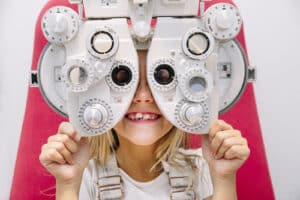Eye care is an important aspect of your child’s health. While your eyes can change throughout your life, they undergo significant development during childhood, and rapidly.
As various structures grow, it can affect your child’s vision. One of the best things you can do for your child is ensure they see as well as they can be.
Keep reading to find out if your child needs pediatric eye care!
Signs Your Child May Need to See the Eye Doctor
The American Academy of Ophthalmology recommends that every child have an eye screening before they turn one, between one and three years of age, and again between three and five. Once your child turns five, an exam every year or two is recommended.

If your child is due for an exam, it’s a good idea to schedule one as soon as possible, even if you or your child hasn’t noticed any changes in their vision. Sometimes, vision problems can fly under the radar.
Your eye doctor can recognize signs that may otherwise go unnoticed.
There are some signs that your child needs to see the eye doctor, regardless of how long it’s been since your last appointment.
One of the most common signs is the child having difficulty reading the board at school. They may squint, or close one eye, to try to see better.
They may hold reading material up to their face or sit too close to a computer or TV. Headaches and eye rubbing can also occur.
If your child is complaining about blurry vision, it’s worth it to schedule an appointment and determine the source of their difficulty so that a solution can be found. For many children, it may be as simple as wearing glasses.
What to Expect During a Pediatric Eye Exam
A pediatric eye exam is similar to an adult eye exam in many ways, but it is tailored to the needs of children and geared toward the fact that their eyes are still developing.
Visual Acuity Testing
After talking to you about any vision changes or difficulties you or your child may have noticed, your child’s eye doctor will test their visual acuity, in other words, how well they can see.

A Snellen chart is one that you are probably familiar with. It consists of lines of letters that vary in size.
Your child will stand or sit twenty feet away from the chart and be asked to read letters of different lines. 20/20 vision means that your child has normal vision: from twenty feet away, they can see what a person with normal vision can see.
The second type of chart is called a Tumbling E chart. This is used if your child does not yet know how to read letters and numbers.
The chart contains Es that are positioned in different ways, such as upside down, sideways, etc. Your child will be asked to look at a particular E and point their finger in the same direction it’s pointing.
In children who are four and younger, sometimes another type of chart is necessary. We have several different ones that are better suited for younger children.
Eye Muscle Testing and Thorough Examination

In addition to testing their visual acuity, your child’s eye doctor will perform a variety of tests to evaluate your child’s eye health. They will check your child’s ocular alignment and color vision.
They will also ensure they are using both eyes equally and that their vision skills are developing normally. Your child’s eye doctor will closely examine the different structures of your child’s eyes, such as the cornea, iris, lens, retina, and optic nerve.
This may involve the use of specialized equipment that provides a better look. The goal is to detect any abnormalities or signs of conditions.
Refraction Test
If your child needs glasses, a refraction assessment will be performed. This often involves having your child look through a machine called a phoropter.
They will be shown a variety of lenses and asked which allows them to see better. This determines their prescription.
What Are Some Common Eye Conditions Seen in Children?
One of the essential purposes of an eye exam is to identify any ocular conditions. That way, it can be diagnosed and treated, so your child can maintain eye health and clear vision.
Your child’s vision can be affected by a range of conditions. Most children who have an eye condition have a refractive error.
This occurs when the eye cannot focus light properly, causing blurry vision. Nearsightedness, farsightedness, and astigmatism are fairly common. 
They can be addressed with glasses. Another eye condition commonly seen in children is called amblyopia.
This is also known as “lazy eye.” Amblyopia is the result of reduced vision in one eye.
This can occur for a few reasons, including one eye needing a stronger prescription than the other and eye misalignment. Amblyopia can be treated with a temporary eye patch or dilating eye drops.
Strabismus is another condition the eye doctor will check your child for. With strabismus, the eyes do not align. It may give the appearance of “crossed eyes.”
Often, glasses are enough to counter this misalignment, but sometimes muscle surgery is necessary.
Is it time for your child to visit the eye doctor? Schedule an appointment at Jacksonville Eye Center in Jacksonville, FL, today!

